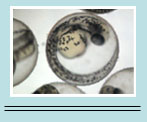

Home
Common Techniques
Classroom Experiments
Virtual Experiments
Tutorials
Games
Glossary
Links
Publishing
Opportunities
About This Site
Contact Us
ZFIN
Cite Us
casanova Experiment
Page 2: The casanova Mutation
Now that you have some general background information about genetic mutations, the more specific aspects of the cas mutation can be explained.
The casanova gene is important to the proper development of the zebrafish cardiovascular system. cas mutants are lacking endoderm, which is nessecary for proper migration of the heart precursors to the midline and for formation of the actual heart. Instead, a cas mutants heart precursors do not migrate, and cas mutants develop cardia bifida: the formation of bi-lateral hearts. Due to the severity of this condition zebrafish larvae with this disorder die relatively quickly.
The cas mutation is classified as a lethal loss-of-function mutation.
How to identify casanova mutants
The easiest way to quickly identify casanova mutants is by the presence of pericardial edema, a clear mass posterior to the head and anterior to the yolk sac, which is not present in wild type zebrafish. Pericardial edema can be seen using bright field microscopy, as in the images below.
Panel A is a side view of a wildtype embryo and Panel B is a lateral view of a casanova mutant embryo. The black arrowheads point to the hearts in both panels-note the large sack of fluid around the heart (the cardia edema) in the casanova embryo. The asterics point to brain vesicles and the arrows point to the yolk extension, both of which are also abnormal in casanova embryos. Images taken from Alexander et al., 1999.
For more specific and detailed information, several scientific papers have been published. The Pub Med database has many of these articles, and can be found here.
Suggested reading includes:
- Alexander, J., Rothenburg, M., Henry, G., and Stainier, D.Y.R. (1999). casanova Plays an Early and Essential Role in Endoderm Formation in Zebrafish. Developmental Biology 215, 343-357
- Glickman, N.S., Yelon, D. (2002). Cadiac development in zebrafish: coordination of form and function. Cell & Developmental Biology 13, 507-513
